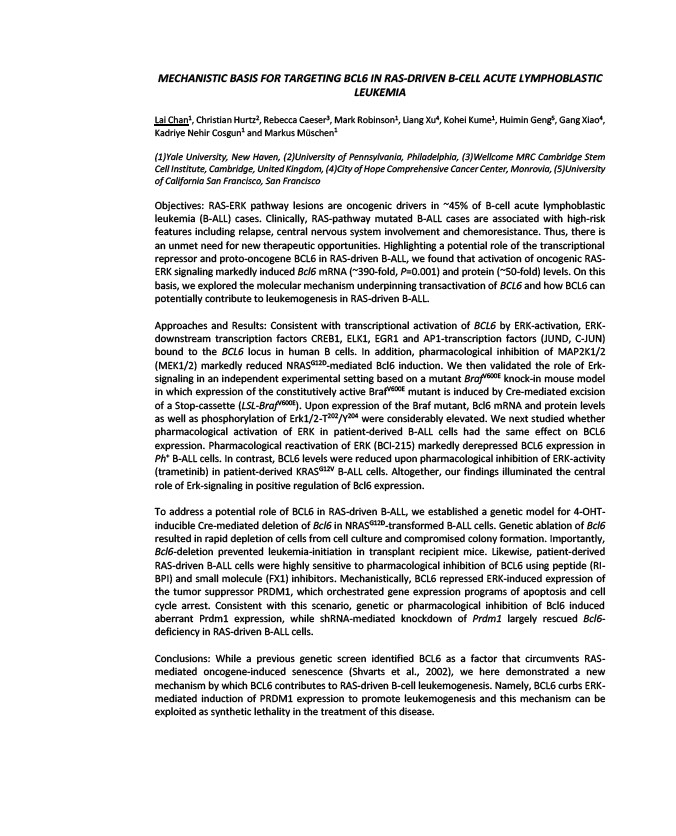
MECHANISTIC BASIS FOR TARGETING BCL6 IN RAS-DRIVEN B-CELL ACUTE LYMPHOBLASTIC
LEUKEMIA
Lai Chan1, Christian Hurtz2, Rebecca Caeser3, Mark Robinson1, Liang Xu4, Kohei Kume1, Huimin Geng5, Gang Xiao4,
Kadriye Nehir Cosgun1 and Markus Müschen1
(1)Yale University, New Haven, (2)University of Pennsylvania, Philadelphia, (3)Wellcome MRC Cambridge Stem
Cell Institute, Cambridge, United Kingdom, (4)City of Hope Comprehensive Cancer Center, Monrovia, (5)University
of California San Francisco, San Francisco
Objectives: RAS-ERK pathway lesions are oncogenic drivers in ~45% of B-cell acute lymphoblastic
leukemia (B-ALL) cases. Clinically, RAS-pathway mutated B-ALL cases are associated with high-risk
features including relapse, central nervous system involvement and chemoresistance. Thus, there is
an unmet need for new therapeutic opportunities. Highlighting a potential role of the transcriptional
repressor and proto-oncogene BCL6 in RAS-driven B-ALL, we found that activation of oncogenic RAS-ERK
signaling markedly induced Bcl6 mRNA (~390-fold, P=0.001) and protein (~50-fold) levels. On this
basis, we explored the molecular mechanism underpinning transactivation of BCL6 and how BCL6 can
potentially contribute to leukemogenesis in RAS-driven B-ALL.
Approaches and Results: Consistent with transcriptional activation of BCL6 by ERK-activation, ERK-downstream
transcription factors CREB1, ELK1, EGR1 and AP1-transcription factors (JUND, C-JUN)
bound to the BCL6 locus in human B cells. In addition, pharmacological inhibition of MAP2K1/2
(MEK1/2) markedly reduced NRASG12D-mediated Bcl6 induction. We then validated the role of Erk-signaling
in an independent experimental setting based on a mutant BrafV600E knock-in mouse model
in which expression of the constitutively active BrafV600E mutant is induced by Cre-mediated excision
of a Stop-cassette (LSL-BrafV600E). Upon expression of the Braf mutant, Bcl6 mRNA and protein levels
as well as phosphorylation of Erk1/2-T202/Y204 were considerably elevated. We next studied whether
pharmacological activation of ERK in patient-derived B-ALL cells had the same effect on BCL6
expression. Pharmacological reactivation of ERK (BCI-215) markedly derepressed BCL6 expression in
Ph+ B-ALL cells. In contrast, BCL6 levels were reduced upon pharmacological inhibition of ERK-activity
(trametinib) in patient-derived KRASG12V B-ALL cells. Altogether, our findings illuminated the central
role of Erk-signaling in positive regulation of Bcl6 expression.
To address a potential role of BCL6 in RAS-driven B-ALL, we established a genetic model for 4-OHT-inducible
Cre-mediated deletion of Bcl6 in NRASG12D-transformed B-ALL cells. Genetic ablation of Bcl6
resulted in rapid depletion of cells from cell culture and compromised colony formation. Importantly,
Bcl6-deletion prevented leukemia-initiation in transplant recipient mice. Likewise, patient-derived
RAS-driven B-ALL cells were highly sensitive to pharmacological inhibition of BCL6 using peptide (RI-BPI)
and small molecule (FX1) inhibitors. Mechanistically, BCL6 repressed ERK-induced expression of
the tumor suppressor PRDM1, which orchestrated gene expression programs of apoptosis and cell
cycle arrest. Consistent with this scenario, genetic or pharmacological inhibition of Bcl6 induced
aberrant Prdm1 expression, while shRNA-mediated knockdown of Prdm1 largely rescued Bcl6-
deficiency in RAS-driven B-ALL cells.
Conclusions: While a previous genetic screen identified BCL6 as a factor that circumvents RAS-mediated
oncogene-induced senescence (Shvarts et al., 2002), we here demonstrated a new
mechanism by which BCL6 contributes to RAS-driven B-cell leukemogenesis. Namely, BCL6 curbs ERK-mediated
induction of PRDM1 expression to promote leukemogenesis and this mechanism can be
exploited as synthetic lethality in the treatment of this disease.